Hamptons
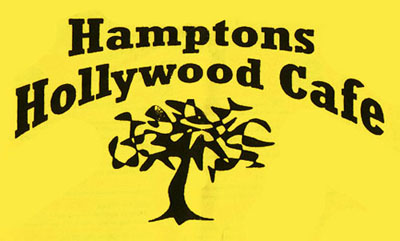
Hamptons (spelled with no apostrophe) was an upscale hamburger joint — perhaps the first one in Southern California. There were in fact two outlets of Hamptons. The original one was on Highland in Hollywood and in the spirit of full disclosure, it should be noted that the proprietor of this site was a part-owner of this one during its last few years of life. The other was out on Riverside Drive in Toluca Lake and it has now been transformed into Mo’s, with some but not all of the old Hamptons menu remaining.
Hamptons was famous as the restaurant that Paul Newman owned. That’s not exactly true but it’s also not utterly untrue. Here is how the story was told to me…
One day in the seventies, Paul Newman was having dinner with a friend of his, Ron Buck. Buck was a writer, artist and entrepreneur who had, among other ventures, built the 9000 Sunset building, as well as a trendy West Hollywood discotheque known as The Factory. He had worked without credit on several of Newman’s films, and he and the actor would later share credit for the screenplay of the 1984 Harry and Son. Buck was also great at cooking hamburgers on his backyard barbecue.
He had recently inherited an old house in which his mother had lived…on Highland Avenue in Hollywood, a few blocks south of Sunset. The other dwellings on the block were now housing real estate offices and Buck was trying to decide if he should sell the property or lease it to some business or what. Somehow, the suggestion arose that he open a gourmet burger restaurant there…a place where folks in the movie business who could afford better than Hamburger Hamlet could get one of Buck’s specialties, served with a glass of expensive wine.
The story then gets a bit murkier. Some say Newman put up the money and Buck put up the expertise and management. Since Buck was pretty wealthy, this may not be true, or it may be partially true. Some say Newman just agreed to be a frequent customer and to allow Buck to exploit that fact in publicity. Either way, the house was remodeled into a restaurant, mostly by enclosing the backyard. There was a wonderful, gnarled old tree in the middle of the yard and rather than remove it, the renovators bricked in the ground around it and allowed the tree to remain, reaching up through an opening in the newly-installed roof.
The place was named Hamptons because it was to reflect the fun and leisure of vacationing in the Long Island community known as The Hamptons. Various burgers were named for various friends and soon, it became a very “in” spot for folks who worked at nearby studios, such as Sunset-Gower or Paramount. The place didn’t do much of a dinner business but at lunchtime, it provided a welcome alternative to the fast food emporiums and taco stands of the neighborhood. At some point, it became so lucrative that Buck opened the branch on Riverside Drive in Toluca Lake. Some say that after Newman had recouped his initial investment thrice over, he withdrew whatever financial interest he had and gave full ownership to Buck. That is, if he even had any financial interest in it.
As you can see the story of Hamptons and Paul Newman’s involvement is a bit fuzzy. I vouch for none of the above, but for the fact that the two outlets of Hamptons became very popular. Once upon a time, it was impossible to get a table at lunch without a long wait. People loved the eighty varieties of burgers, including Stan’s Fantasy (with sour cream and black caviar), The Nelly Burger (creamed horseradish and bacon) and The Foggy Bottom Burger (peanut butter and sour plum jam). People also loved the little buffet that accompanied each burger, allowing you to further dress your sandwich and pile the plate with salads and side dishes. The menu did not include french fries — odd for a burger joint — but if the German Potato Salad available in the buffet wasn’t to your liking, you could order a platter of Potatoes Hamptons, which was basically hash-browns with sour cream.
I have dozens of memories of Hamptons, commencing when I worked at various studios up in Hollywood and we’d eat there once a week. It was a great place to spot celebrities and/or talk about that new screenplay. One friend of mine said it was the best place in Hollywood to meet out-of-work actresses who were waiting tables.
One time, I was lunching with the star of a TV special I was producing and we had a little trouble with a fellow at an adjoining table. He was a bit drunk and he kept banging his chair into our table and acting like it was our fault. Finally, my dining companion told him to knock it off, and the drunk stood up like he was ready to start brawling. My friend stood up to face him and the inebriated gent suddenly realized he was staring at famed dirty wrestler, Roddy “Rowdy” Piper. He immediately paid his check and left, and Roddy and I returned to our burgers.
This was in the mid-eighties. As that decade ended, so did the popularity of a lot of restaurants in Hollywood. An amazing percentage of them folded and Hamptons, while it managed to stay open, was rarely crowded. It also wasn’t very good. I believe — again, this is fourth-hand info, maybe more — Buck passed away, as did the fellow he had managing the two eateries for him. Whoever was running it tried a lot of different things, including the introduction of french fries but it didn’t help. Around 1990, I had a meal there that was so lousy, I scratched Hamptons from my list of places to go. I was not alone in this decision.
Then just a few years later, the two outlets of Hamptons were put up for sale, and were quickly purchased. One group of investors bought the one in Toluca Lake, completely renovated it and since they didn’t get custody of the name, reredubbed it “Mo’s.” The original Hamptons on Highland became Hamptons Hollywood Cafe and the group that purchased it also did a lot of remodeling, bringing in a new chef and adding new items to the menu. For some reason, they installed a “car phone” in the parking lot…a phone booth made out of an old Nash Metropolitan. And they rounded up a number of investors, one of whom was me.
I never expected to make any money off my investment and, indeed, I didn’t. The whole point of it was to be able to say to friends, “Hey, let’s have lunch at my restaurant.” Taken on that basis, it was a lot of fun. The folks who actually operated the place had a lot of good ideas, some of which were quite amusing. Since Hamptons had catered largely to an industry (show biz) crowd, they instituted an unusual pricing policy. Members of the Screen Actors Guild, Writers Guild and Directors Guild paid 10% less, while agents had to pay 10% more. The latter was meant as a joke but amazingly, there were actually diners who said, “I’m an agent. Do I really have to pay 10% more?” A few of those who asked were told yes, and they did. Wouldn’t you love to have one of those folks negotiating your deals for you?
The quality of the new Hamptons varied a lot. Sometimes, it was a great place to eat; sometimes, not. I didn’t have much to do with it except to (a) rewrite the menu to make it sillier, (b) make occasional suggestions and (c) add one menu item: The Groo Burger, based on the way my partner Sergio Aragonés likes his served…Grilled onions on top, then Mozzarella and Cheddar melted over the onions. I also had the supreme honor of having the barbecued chicken sandwich named for me and so consumed many.
But business was never too good and finally, the place was sold to a developer. For several months, it was “closed for remodeling” but no remodeling occurred. Instead, they finally tore down the house where Ron Buck’s mother had once lived, and even uprooted and removed that grand, majestic tree. The land now has on it a mixed-use structure (offices and residences) called Hampton Place. I already miss Hamptons and it’s not my investment I miss. I made a few bucks. I just always found it to be a friendly place to lunch with real good burgers and a great crowd. What more could you want?
Lawry’s
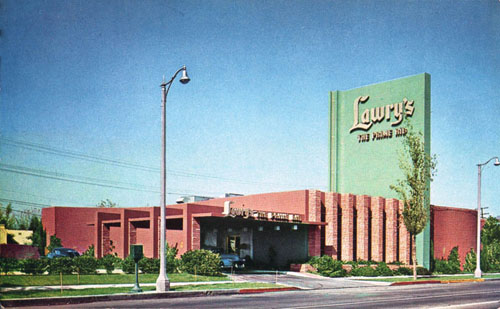
This is a bit of a cheat since Lawry’s is still very much in business but I have a certain nostalgic feeling for the building wherein I first tasted their fine, fine prime rib. Originally, Lawry’s was in a building on the east side of La Cienega. Then they outgrew that and in 1947, they moved into the above building on the west side of the boulevard. A few years ago, they rebuilt the old building and moved back into it, and the building depicted above turned into a restaurant called The Stinking Rose, where everything (including — no kidding — the ice cream) is rife with garlic.
As you probably know, when you dine at Lawry’s, your piece o’ meat is served to you by a man in a chef’s outfit with a medallion around his neck. He rolls a hefty, gleaming serving cart filled with cooked cow to your table and slices off the appropriate hunk. When Lawry’s moved across the street, the chefs rolled their carts (presumably empty) out of the old locale, then police stopped traffic on La Cienega and allowed them to push their serving stations across the boulevard and into the new building. Every time I drive up that street, I imagine a traffic sign with a little silhouette of a chef pushing a serving cart and the words, MEAT CROSSING.
Here’s a story about Lawry’s — and actually it took place at the other building, the one on the east side of La Cienega. But it could have happened at the one in the photo at the top of this item.
I was dining with a lady who liked milk and usually drank a few glasses of it at every meal. We were down near the end of our consumption. I think I had two more bites to go on my Diamond Jim Brady cut with the mashed potatoes and the creamed corn and I was beyond stuffed. I could feel seams on my skin straining under the stress. My date picked up her glass and suddenly, the bottom exploded and milk flew in every direction. Our table was covered with it.
But only for about thirty seconds. Lawry’s has spectacular service. Instantly, three or four bus boys were upon us with rags. In less time than seemed humanly possible, they’d removed every single thing on our table, dried the table, put another tablecloth in place and brought in new place settings, salt, pepper, etc. And while this was happening, unnoticed by us, our waitress hurried over to one of the gleaming carts and had the carver remake our entrees. Suddenly, it was like time had rolled back twenty minutes: In front of me was a full serving of the Diamond Jim Brady cut with the mashed potatoes and creamed corn and my date had her full dinner all over again. It transpired so rapidly that I couldn’t say, “No thanks, I couldn’t eat another bite.”
We took a few forkfuls of our refurbished dinners, then had them boxed to go. As we were leaving, we passed a man in the next booth who had seen it all, even though we hadn’t seen him. It was Jack Nicholson and he grinned that devilish smile that impressionists can never quite replicate and he said, “Nice trick there with the milk.”
The Hogie Hut
The best submarine sandwiches in town used to come from a place called The Hogie Hut which was located near (not on) the Southeast corner of La Cienega and 3rd Street. I lived about a block away for a while so I was often in there having the meatball sub, which was quite delicious and filling. Half of one could feed you for a day but alas, meatball sandwiches don’t keep well. There never seemed to be any point taking half home so I’d always overeat, stuffing down a half more than I really wanted.
Their house special was a thing called the Godfather, which was quite an array of Italian cold cuts, lettuce, tomato and provolone. All of their sandwiches were available in lengths of three feet and above for parties but the manager there told me once that most people who bought by the yard ordered the Godfather. He told me this as his staff was wheeling out the components of one that would look like it was eight feet long at some party. Of course, it was really eight foot-long sandwiches lined up and cut into two-inch segments.
I was surprised when this place went away. It seemed like an institution there on Third Street, right across from the Souplantation. There were times I’d be sitting in the Souplantation eating soup and healthier fare, looking out the window and thinking how nice a big meatball sub, bulging with meatballs and dripping cheese and marinara sauce would be.
Kelbo’s
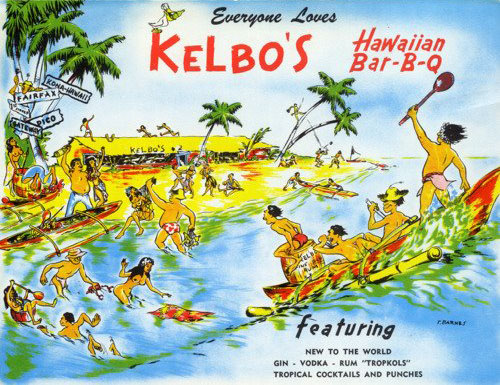
Two men, Thomas Kelley and Jack Bouck, combined the first syllables of their last names and invented Kelbo’s, a small chain of Hawaiian barbecues that were not all that Hawaiian: Burgers, barbecue meat sandwiches and some miscellaneous seafood. The concession to the islands was that every plate was garnished with a piece of pineapple and the fried shrimp was coated with coconut. They also served very sweet (but very good) barbecued ribs and had a menu of tropical drinks, some of which came flaming or served in a skull mug. About half of each restaurant was a large, dimly-lit bar that I suppose some found atmospheric. I never saw anyone there who looked like they might have been a hooker but given the mood, it wouldn’t have surprised me.
What was Hawaiian — and much of the appeal of the places — was the decor which was comprised of tiki gods, fish nets, lanterns in the shape of pineapples, and other things you could buy at any cheap patio furniture shop to suggest a real cheesy tropical motif. Some of it seemed to have come from a chain of stores that existed in L.A. in the early sixties called The Akron. A gentleman named Eli Hedley was reportedly the main designer and he also was responsible for the interior of other tropical-themed restaurants like Don the Beachcomber. I don’t know when Mr. Hedley did that voodoo that he did so well but Kelbo’s felt like a place that had been decorated in the thirties or forties and then no one changed anything.

I frequented two Kelbo’s. One, on Fairfax across from CBS Television City, was torn down and there’s an outlet of The Vitamin Shoppe at that address today. It was a popular hangout for crew members who worked across the street at CBS Television City in the fifties and sixties.
The building that housed the other was over on Pico at Exposition. It still stands but has been converted into a bikini bar called Fantasy Island. I haven’t been inside since it stopped being Kelbo’s but I’ll bet they kept some of the old Hedley-selected furnishings and tiki tchotchkes.
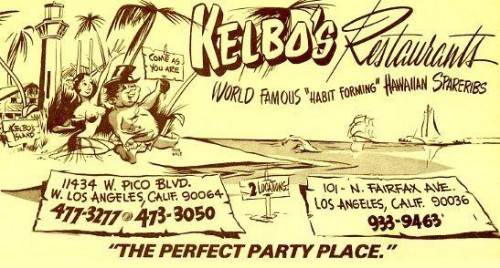
Click above to enlarge a little
One other thing that interested me about Kelbo’s was that much of its advertising art —like the drawing above — was done by a gent named Bob Hale who otherwise turned up on Los Angeles TV from time to time as a cartooning weatherman. (He was also active in Seattle where he owned a popular hobby shop that bore his name.) Hale’s drawings of a fat Hawaiian guy in native garb could be seen on Kelbo’s napkins and menus, and both of the outlets I visited had had huge Bob Hale murals on the outside, all featuring his little signature character, Sammy the Seagull. Sammy was always being drawn into his TV weathercasts, shivering or tanning himself depending on the forecast. It was said that Mr. Hale had once had a severe drinking problem and that after he quit, he lectured and illustrated pamphlets for Alcoholics Anonymous or some such group. Which always made me wonder why he had done so much work promoting a place where a lot of people just went to drink.
Schwab’s Pharmacy
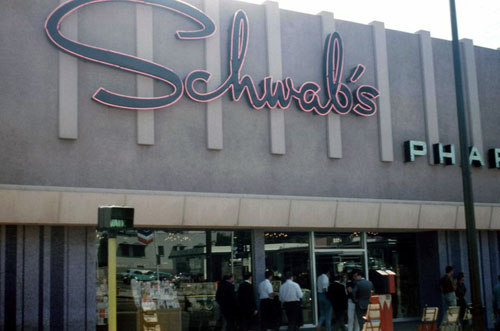
Legend has it that Lana Turner was discovered for movies as she sat at the lunch counter at Schwab’s Drugstore at Sunset and Crescent Heights, which is seen in the above picture. This is almost certainly not true. For one thing, they used to tell that story as if it had occurred at one of the other Schwab’s Pharmacies — the one further down Sunset near Doheny. When it was torn down, the legend shifted to the one at Crescent Heights. And the story probably wasn’t true even before that because Ms. Turner always told people she was spotted by a talent scout in a cafe called the Hi Hat across the street from Hollywood High School. (And even that may not be true, as others say she was found via agents and the usual submission process, and the whole story of being discovered while eating lunch was a press agent concoction.)
So then, what was the big deal about the Schwab’s at Sunset and Crescent Heights? Beats me. Seemed to me like a perfectly ordinary, poorly-stocked drugstore with a small luncheonette area. My impression is that in the sixties and maybe before, as big chain drugstores grew all over Southern California, less and less of Schwab’s business was in that area so they kept expanding the dining sections. Most of what they sold in the drug/pharmacy area seemed to be makeup such as a wanna-be actress might purchase.
But the lunch area was pleasant enough, and while you couldn’t get discovered there, you might spot a lot of people who had made it into movies and TV shows…maybe not in the star roles but it was a big hangout for actors. I don’t mean Big Stars. I mean (mostly) supporting players, including many of the “Oh, that guy” variety where you know the face but can’t place the name to save your life. I don’t think I ever ate there without seeing Dick Miller, who was so good in all those Roger Corman pictures.
During Breakfast hours, it was practically like a club — the same folks at the same tables. When Schwab’s closed down in 1983, that group began drifting from restaurant to restaurant, never managing to find a venue that was as good and actor-friendly. In the meantime, the old Schwab’s location was torn down, replaced by a shopping center built around a Virgin Megastore. Also demolished to make way for that complex was Harry’s Wood-Pit Barbecue. The Virgin is gone now too and there’s a Trader Joe’s and other businesses in its stead. They’re all probably nice places but I’d much rather have Schwab’s and Harry’s.
Anna’s
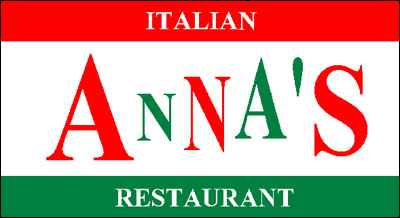
The best Italian restaurant I ever found, Zito’s, closed on Pico Boulevard (just west of Westwood) in 1969, the same year I graduated high school. Those two events may have been connected because Jo Anne Zito, daughter of the owners, was in my class and she graduated at the same time. With no evidence whatsoever, I’ve always thought that the Zito family was just waiting for Jo Anne to get her diploma before selling the restaurant and moving out of Los Angeles.
A new Italian restaurant named Anna’s moved into the building, at first keeping pretty much the same decor. I ate there once, resented the place for not being Zito’s, and decided not to go there again. I believe I had spaghetti and meatballs and wasn’t impressed. That’s what I usually order the first time I go to an Italian restaurant — spaghetti and meatballs. I figure if they can’t do that right, there’s no point in trying anything else.
A few years later, enough friends had told me how great Anna’s was that I decided to go give ’em another try. I was glad I did. I still wasn’t wild about their spaghetti but they had other things on the menu that were quite wonderful…especially the Cannelloni Napoletana. You got two large crepes stuffed with ground beef, cheese and the tiniest bit of spinach, all covered in a red sauce or a white sauce. It was one of the best dishes I ever had in a restaurant and it prevented me from sampling much else on the Anna’s menu. I mean, why bother? It wasn’t going to be any better than the Cannelloni Napoletana.
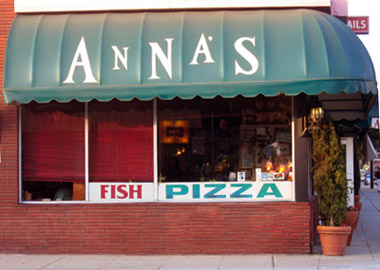
The other thing I liked best about Anna’s was walking up to it. It was on the corner of Pico and Kelton. On Kelton, there was a large vent from the kitchen and to walk past it was like being in a garlic sauna that could have melted Count Dracula on the spot. It was really an arresting sensation to get that burst of warm, garlic-infused air. Every time I took someone there, I made sure to steer them past the vent and to alert them to get ready. They all inhaled deeply and said, “Now, that’s how an Italian restaurant is supposed to smell!” I miss that as much as I miss the Cannelloni Napoletana.
Lastly, an honorable mention for the waiters. Anna’s had great ones. They were career professionals, not outta-work actors, and some were there 20+ years. They could be surly at times, especially with folks who’d peruse the menu for a half-hour then ask, “What’s good here?” But the service was first-rate and they really cared about you liking your food.
Anna’s was there 41 years…until June of 2010. The owners received an offer they couldn’t refuse from another restaurant that craved the real estate…so they sold. Good for them. Bad for lovers of good Italian cooking.
Little Joe’s
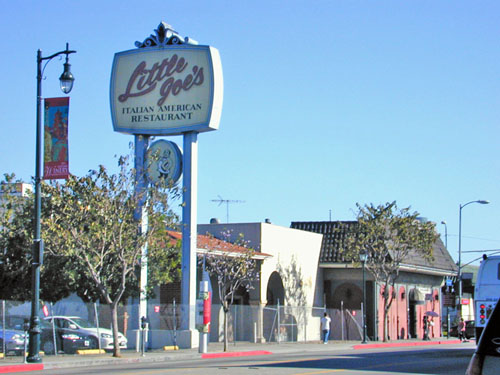
Little Joe’s was a very famous Italian restaurant in Los Angeles. And it was located just where you’d expect to find a very famous Italian restaurant: In the middle of Chinatown.
The institution started life in 1897 as the Italian-American Grocery Company at the corner of 5th and Hewitt Streets. One account says its founder-owner was Italian-born Charley Viotto. Another credits a man named John Nuccio, also an Italian immigrant. Around the turn of the century, the city’s Italian immigrant community relocated to the North Broadway area and the market followed in 1907, settling into the ground floor of a three-story hotel at Broadway and College. Eventually, the market turned into a restaurant and the hotel was torn down and replaced by a building that was just a restaurant — and a very nice one.
Along the way, the name was changed. After World War I, a number of Italian-American businesses changed their names to de-emphasize Italian heritage and some theorize that this prompted the restaurant to become Little Joe’s. In 1922, John Nuccio (who if he didn’t found the establishment seems to have acquired it by then) retired and sold out to his best friend, John Gadeschi. Nuccio’s son went to work there after serving in World War II and when he married Gadeschi’s daughter, control of Little Joe’s returned to the Nuccio family and remained there ever after.
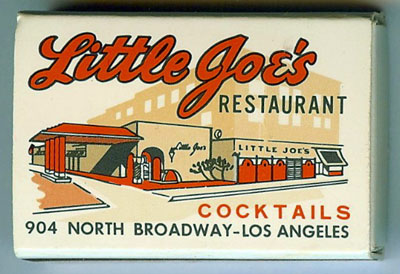
In the forties, Little Joe’s became a favorite hangout of Hollywood stars. It is said that when W.C. Fields was staying at a nearby hospital to deal with alcohol abuse, he sometimes slipped out and hustled over to the bar at Little Joe’s for cocktails. When the Dodgers moved to Los Angeles in the fifties, Little Joe’s became a big hangout for fans of the team. Located not all that far from the stadium, it was a place to go before a game or — better still — after, when players were known to stop in. If the game was being televised, some people would decide to not hassle the parking and just watch it at the bar in Little Joe’s.
Over those decades, the neighborhood morphed into Chinatown. Little Joe’s was eventually the last major business for blocks around that wasn’t Asian in ownership and/or commerce. Business declined. It may have been the city’s oldest Italian restaurant but it was not its most convenient. As the building came to need major renovation, the Nuccio family decided it didn’t warrant the investment and Little Joe’s finally closed down in December of 1998. It was announced that the structure would be razed and an apartment and retail complex called the Chinatown Blossom Plaza would be built in its place at a cost of $162 million. But those plans fell through and the last time I was down there, the old Little Joe’s building was still standing, signage intact, fenced-off and looking pretty sad. Reportedly, a new shopping plaza is finally being erected there now.
I was only there once. For years, my family and I had heard of Little Joe’s. It was a very famous place to slurp pasta and everyone in my family was eager to try it. Everyone but me, that is. At the time, my favorite Italian restaurant was Zito’s which was much closer and where we never had a meal we didn’t love. So why travel all the way downtown to try a place which, at best, might be just as good? Good question. And the answer was that my Aunt Dot was on a “try new things” kick, lecturing us that there was something wrong with a person who stuck with the same old, same old. In 1969, on the day I graduated from high school, it was decided we’d follow the ceremony with a big family outing to some restaurant. Somehow, though it was my Graduation Day, I didn’t have a vote in the matter. We were going to Little Joe’s.
It was a long drive and a long wait for a table, and then the food failed to thrill us. When that happens in a place like that, you wonder if something’s wrong with you. After all, thousands and thousands of people have raved about the cuisine. It can’t be as bad as you think it is, can it? How could they be open all those years and have such a great reputation with mediocre cuisine? But they lasted a long time without, obviously, my business. Guess we just caught it on an off-night.
The Hungry Tiger

The Hungry Tiger was a chain of seafood restaurants around Southern California. At one point, there were forty-one of them, including one in Westwood Village, another one on Sepulveda near LAX, and yet another on La Brea just South of Hollywood Boulevard. Those were the ones I went to, and I’m not sure why because I never particularly liked the food at them and insofar as I could tell, neither did anyone else. The secret of their success seemed to be location, location, location. They were the only “nice” places to take a date or client in certain areas. For instance, if you picked up someone at the airport and drove south, the Hungry Tiger on Sepulveda was the first “decent” place to dine you encountered. They got a lot of post-funeral traffic from the nearby Hillside Memorial Park, too.
The chain was started in 1962 by, the story goes, a group of former Flying Tigers’ combat pilots. Some of the first outlets resembled hangars more than restaurants and all were decorated with photos of old planes and aviators. I’m not sure many patrons understood the connection.
In the early eighties, business fell off substantially, apparently due to an influx of strong competitors into the marketplace. The Hungry Tiger chain needed to remodel and upgrade but lacked the funds to do this so in 1985, a new management team was brought in, some of the less profitable outlets were closed and a general relaunch was attempted. It failed to turn around public abandonment of the eateries so in the years following, most of them closed and a few went independent. There are still Hungry Tiger restaurants around but not as part of a large chain.
The last time I was in one, it was the one in Westwood. This would have been around 1980. My date and I were going to a play at the Westwood Playhouse and with parking being as difficult and expensive as it was up there, it seemed logical to dine at the Hungry Tiger that was in the same block as the theater. We could park once for both, get validated at the restaurant and…well, you get the idea.
We both ordered the broiled shrimp and when it came, it turned out to be the kind served in the shell…not my favorite way of having shrimp. When they serve it that way, you always seem to spend forever digging the meat out and there isn’t very much of it. These had almost none. My lady friend and I were amazed at how little edible shrimp flesh you got in a serving of Hungry Tiger broiled shrimp. It was barely one mouthful. We mentioned this to our server who called over a manager who basically told us, “That’s our broiled shrimp. If you didn’t get enough to eat, order something else and pay for an additional entree, heh heh.” Those weren’t the precise words he used but they were close. There was definitely no concern that we weren’t happy with our meals. We would have done what he suggested if there had been time before the play, except that (of course) we would have done it at another restaurant.
After the play, we decided to go somewhere and actually eat, rationalizing that at least the hefty tab I’d played at the Hungry Tiger had gotten us our parking at a discount. It turned out that despite the posted signs, the lot no longer honored Hungry Tiger validations and I had to pay full price to get out. The next day, I wasted about an hour calling the restaurant and the corporate offices of Hungry Tiger to complain. The attitude I encountered was along the lines of “If you don’t like it, eat somewhere else.” Thereafter, I did…and wasn’t surprised that so many other people did, as well. Beware any business that names itself after a voracious predator.
Victoria Station

At last report, there was only one outlet remaining of this once-proud chain…in Salem, MA stands the last of the railroad-themed restaurants known as Victoria Station. The first of them, which was opened in San Francisco in the late sixties, was an outgrowth of a graduate project by three students at Cornell University Hotel School, Bob Freeman, Peter Lee and Dick Bradley. Their new eatery, colorfully decorated with pieces of old trains and London-style phone booths, caught on big and soon there were approximately a hundred of them in existence, including the one I frequented. It was at Universal Studios, not far from where the famous studio tour commenced. The Victoria Station there was huge and it was said to be one of the top-grossing restaurants in America. Based on the crowds, I wasn’t surprised to hear that.
The specialty of a Victoria Station was prime rib but you could also get a steak or ribs or roast chicken or Shrimp Victoria, which was like scampi but without vast amounts of garlic. The food was all pretty good but I recall some long, long waits for a table and if you weren’t going on the Universal Tour (and I never was) the parking could be quite inconvenient. It was a place I’d never choose to dine but business associates kept asking me to meet them there for meals, and its banquet room housed many a party I felt I had to attend.
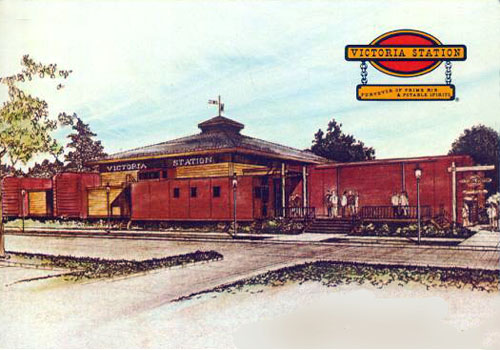
One nice feature of that Victoria Station (and perhaps others) was the employee morale. The folks who worked there liked working there, and the chain was often written up as one of the more benevolent employers in the country, offering its workers stock options and other unusual benefits. In keeping with the railroad theme, Johnny Cash did their commercials.
So what happened to this successful chain? Its one-time Director of Marketing, Tom Blake, authored a whole book on the subject that charged arrogance and mismanagement at the company’s highest levels destroyed the business. News reports at the time seemed to substantiate his view, which was a shame. All the folks who worked there seemed so happy to be working there.
Tail o’ the Pup

One of the most famous structures in Los Angeles — it seemed to get in every montage of city sights — was the hot dog stand that looked like a giant hot dog. Tail o’ the Pup was built in 1946 and opened near the corner of La Cienega and Beverly Boulevards with a real, star-studded Hollywood-type gala. It was built by a man named Milton Black and its original owners were the dance team of Veloz and Yolanda. It was a way of investing their show biz earnings in something more stable. The dog, by the way, was 17 feet long and was basically a front piece that fit onto a more conventional kitchen trailer.
Around 1971, a man named Eddie Blake bought it and thereafter operated the stand with the help of his son, Dennis. Dennis eventually took over the family business and the Blakes did a pretty good job. Obviously, the novelty attracted customers but the quality of the dogs kept them coming back.
All was well until 1985 when the landlord decided to build a luxury hotel on that corner. The Blakes moved their big dog over to San Vicente. A few years later, an expansion of facilities at the nearby Cedars-Sinai Hospital displaced them again. Unable to find a suitable new location, the Blakes moved the giant frankfurter into a storage facility as they dickered for a new address. At last report, they’re still looking and they say that when they do find the right plot of ground, the big wienie will come out of storage and they’ll slap on a new coat of paint — or mustard or whatever — and set up shop.
I’ll bet they do it. The stand is too famous not to be part of the L.A. landscape once again. When they manage it, I’ll amend this item…but right now, it’s an L.A. restaurant that ain’t there no more.
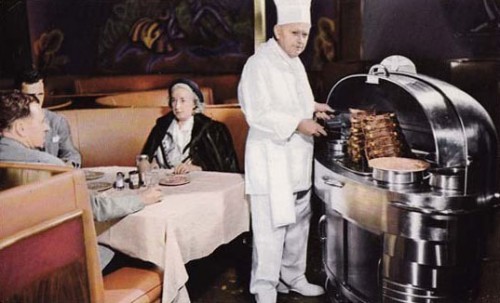
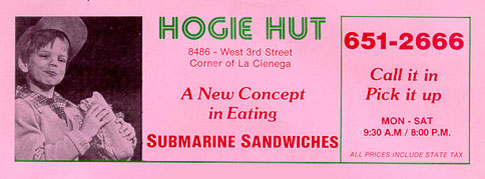
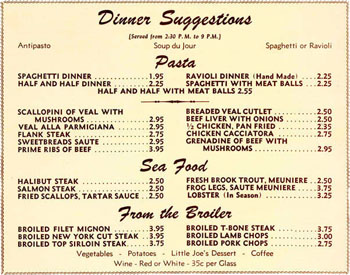






Recent Comments